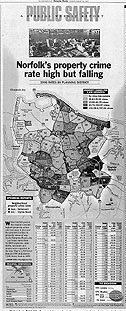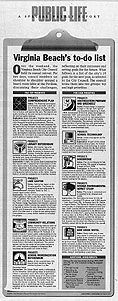Fall 1997
Changing the Personality of Local News Pages
By Dennis Hartig
Managing Editor, The Virginian-Pilot
About one in three express dissatisfaction with the coverage they find. So, every day we leave tens of thousands of people disappointed with reports basic to community life and essential to our success as a local newspaper. That’s not good for the public or The Pilot. Unhappiness with news coverage must contribute to disinterest in public affairs. The opposite must be true, too. In March, we began using public journalism on weekly pages devoted to these three topics in hopes of better serving the public interest even as we served our own self-interest. One page each week is devoted to each topic. Some of the columns and features — bulletin boards, success stories and crime watch columns — could be found in just about any newspaper. But conventional content alone would not get the job done. So, we created new ones, such as school report cards, municipal “to do” lists, a neighborhood exchange and crime maps. The real difference is not in the content, but in the public journalism principles the pages try to observe routinely, the well-defined public purposes that serve as boundaries for story assignments and news judgments, and the civic nature of the questions the pages pose. In our news columns we answer these questions: What’s happening now that’s interesting or important? Or is about to happen? Who’s involved and why? Not on these pages.
Approximately 400,000 people open The Virginian-Pilot regularly for news about crime, city government and schools.
August 20. Public Life.
“Virginia Beach’s to-do list” performs two kinds of public work: accountability and coherence. Many people fault journalists for fragmenting issues into so many tiny pieces that meaning is obscured. This device identifies top community priorities, the status of the work and the next step. By showing the status of vital work, it enables people to hold public officials accountable.
“Neighborhood Exchange” highlights community problem-solving and provides role models of ordinary people doing important work. “Yesterday” is a concise summary of actions taken by four city councils the day before. It serves as an index to more detailed stories and it enables people to keep up with other neighboring cities with a minimum investment of time. The questions in this “Q and A” come from ordinary people.
The question behind these pages is more public: What do people need to know regularly that will enable them to participate more effectively in the public life of their community? The trick is to make the pages read like news, not scholarship, so they will be interesting and inviting. For example, a continuing feature on the Public Life page is a report called “How Your Tax Dollars Are Spent.” It ties the spending to a community concern and identifies the factors, including money, that have influenced the spending levels.
A statement of purpose is crucial to the development of more civic newsgathering routines that we hope will become second nature. For each page, a purpose statement with three or four objectives guides the decision-making and story selection.
The objectives differ from page to page, but all three have common ideas:
- Scorecards on schools, government and police, and courts. This is the objective of the Public Life page: “To provide political information that people can use to monitor more effectively the performance of public officials and public programs.”
- Columns showing ordinary people making a difference. An example: “to give people ideas and examples of things they can do to make themselves and their communities safer.”
- Stories that focus public attention on a vital few public priorities. An example: “to concentrate on people’s concerns with the education of their children, as a way of identifying the choices for action and their consequences.”
Public Journalism Ideas
The most subtle difference comes from the public journalism ideas that inform the page. They give the pages a pragmatic, optimistic tone. These are the public journalism principles:
- Frame politics as community problem-solving, not as a contest between competing interest groups.
- Create coherence by describing the big picture surrounding an issue, reminding people of the issue’s history and what’s at stake for the community.
- Recognize that people will try to make a difference only when they see some possibility that they might influence the outcome or that their opinion will be respected.
- And most importantly, try to characterize ordinary people as important civic resources, not as passive consumers or bystanders.
We picked these and not others, because they were easier to do and responded best to the complaints about the local news report.
All three pages contain six ad-free columns and are designed identically. The two outside columns contain rotating features with helpful information or stories on people making a difference. (The principles at work: Sense of possibilities, ordinary people as important community assets.) One of the big successes is a weekly column on the Public Life page called “Neighborhood Exchange.” It highlights community problem-solving in neighborhoods. It has generated hundreds of calls, not to staff writer Mike Knepler, but to the subject of the column. In this way, Knepler has helped to spread practical solutions to prevailing neighborhood problems and to build networks of people with similar concerns. That’s important public work.
The four center columns of each page contain a mainbar whose primary purpose is to provide people with a performance assessment or report card. (Politics as problem-solving, coherence.)
On the Public Safety page, the report card is a monthly feature showing crime rates in all of the neighborhoods in each city we cover. A regular reader will know how safe he or she is in relation to other neighborhoods, the city, the region and the state. Several times a year we focus on crime rates in public places where large numbers of people gather: downtown, malls, college campuses. On the other three weeks of the month, the page is generally dominated by a crime trend analysis. For example, the page has featured stories documenting a rise in marijuana use among younger teens, the likelihood that the elderly will be the victims of a violent crime (least likely, contrary to the prevailing fear in the community), the effectiveness of police bicycle patrols in reducing petty crime, the movement of the drug market from city to city. The objective is to build broad public understanding of the true risks, not the inflated perception.
On the Public Life page, the report card can be a detailed graphic showing voting trends of office holders, a “To Do” list showing a city’s top priorities, their status and the next step, or a “How your Money is Spent” feature exploring important financial issues that often get omitted from news reports. The objective is to keep the public up-to-date on progress the community is making against major problems.
On the Education page, the idea of a scorecard has been rendered as a report on the percentage of students in each high school scoring A’s, B’s, C’s, D’s and F’s. It has compared the job placement rates and graduation rates of area colleges and universities. And it has examined how community politics and finances affect the eligibilityof students for special gifted and talented school programs. The objective is to give the public information they need to hold their school systems accountable.
There’s a big payoff for The Pilot if this works: If we’re successful, we believe that we’ll see the results in greater demand for what we do, demand that will show up as increased readership and circulation. Other benefits would come, too. The habits of mind the pages require could make our daily coverage more useful and could, in effect, popularize public affairs. That would be an important public good for Virginia Beach, Norfolk, Chesapeake, Portsmouth and Suffolk, the five principal cities we serve.
It’s too early to say whether the experiment is working. It will be another year before we can make any conclusions. But some things are clear:
The pages are changing the personality of the local news report. The every-day coverage does not dwell on controversy, as it once did. Increasingly, it penetrates to the underlying ideas or values in conflict, the real choices and the probable consequences that fuel the division.
 | August 26. Public Saftey. The front page story “27% fewer cars stolen in 1996” is an example of a story we would not have except for the routine created by the Public Safety page. In preparing “Norfolk’s property rate high but falling, “the reporter found the drop in auto theft rates. The story examined the reasons. Twice a year, we publish a crime map for every city, once showing violent crime, once for property crime. We call this approach “facts to fight the fear.” It enables people to assess their relative safety in the neighborhood, throughout the city and compared to neighboring cities. |
It’s less dominated by officials. We’re showing ordinary people doing politics — which we define as community problem-solving requiring shared decisions — as important players.
The reporting routines are starting to produce stories we never would have had a year ago. One of our best pieces of education reporting this year started as an idea for the Education page. It was to have been a weekly explanation in simple language of new curriculum standards. It ended up as a six-day series framed to help parents cope with the increasing demands. Two years ago, this would have been framed as a controversy among educators.
Because we closely monitor crime trends, we’ve identified inner-city neighborhoods without a single crime and how the people in the neighborhood looked after one another. In another we found a 25 percent drop in auto thefts and traced it back to preventive steps taken by merchants in high crime areas.
Reporters remain unenthusiastic. That’s understandable. They can spend three to five days on these stories, time they think would better be devoted to stories that would compete for Page One.
Readers have reacted positively. Every three months we ask readers how satisfied they are with The Pilot. In a survey taken three months after the launch of the pages, the percentage of people saying they were “very satisfied” or “extremely satisfied” with education coverage climbed from 6 in 10 to 8 in 10 after the first three months. There’s been no change in city government and crime coverage scores. The three pages already have found an audience of about 225,000 per week. And the research suggests our approach is particularly popular among a group of readers who have been indifferent to our more traditional approach to government, crime and school stories.

